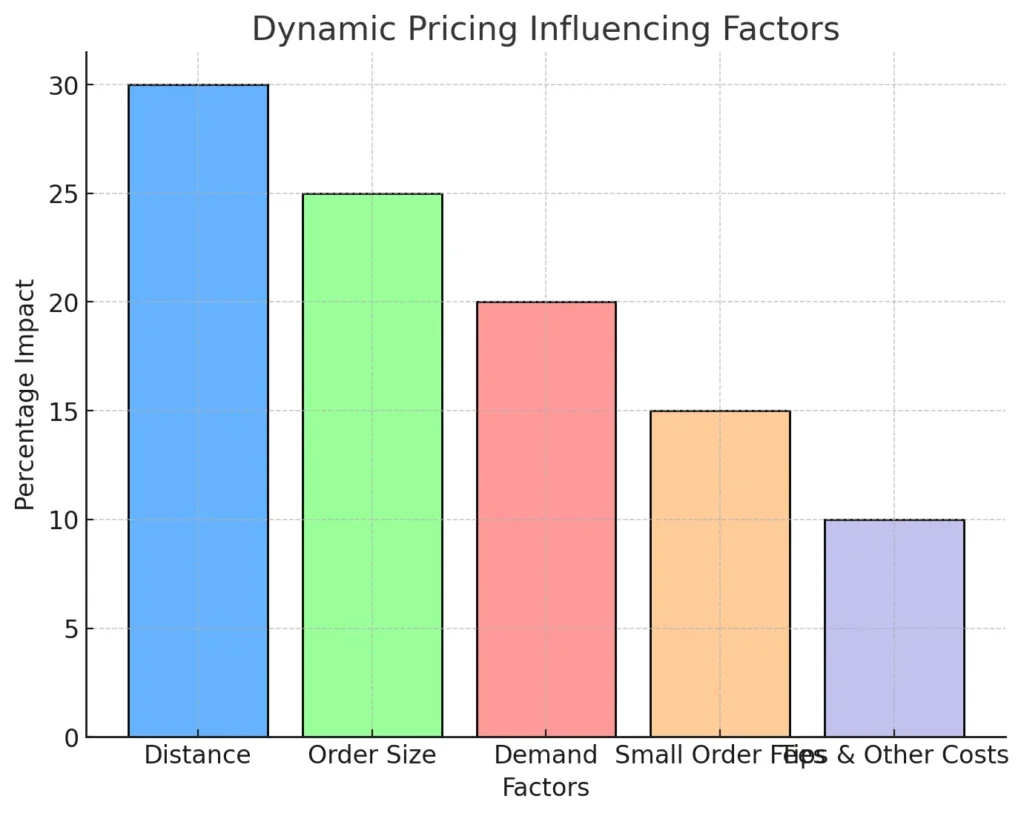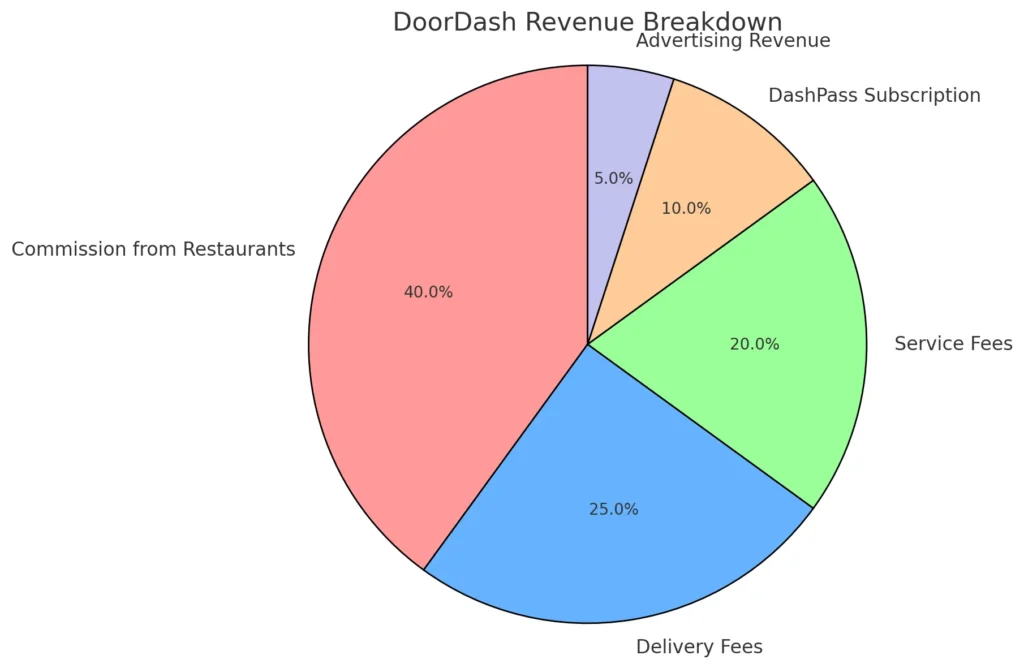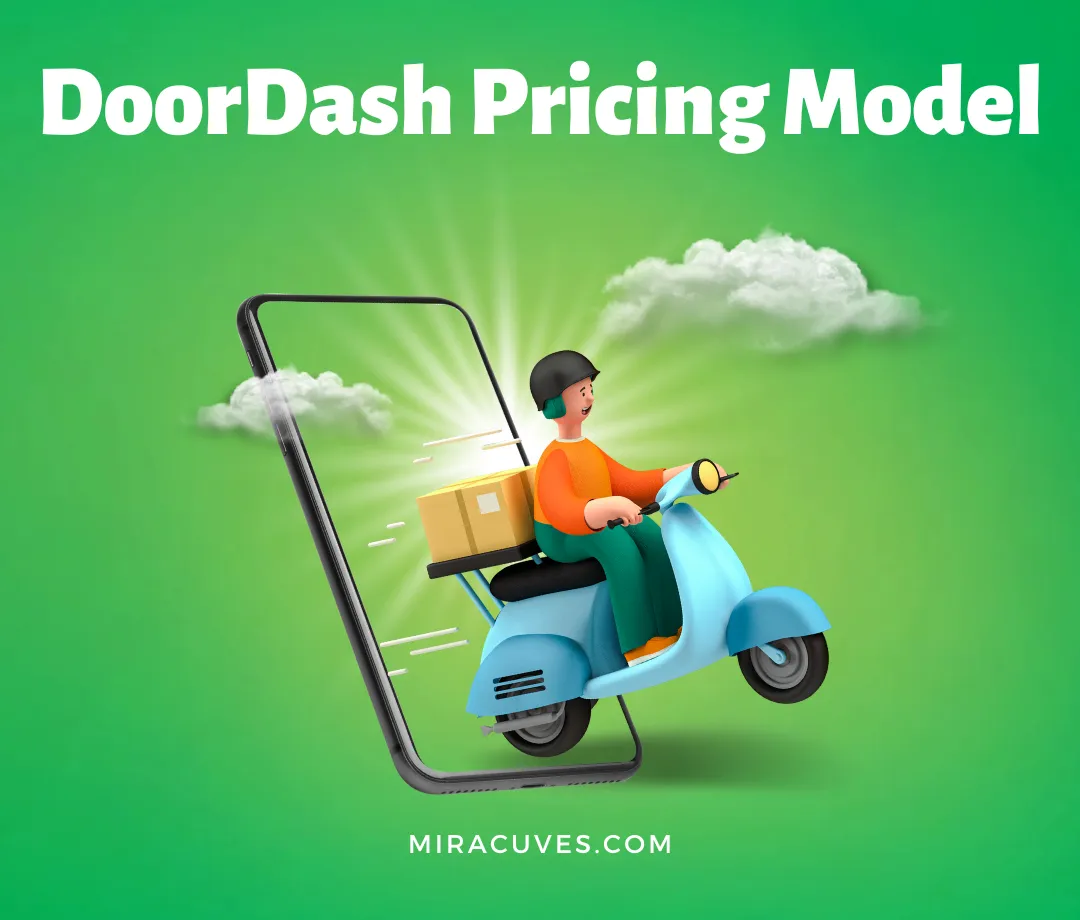DoorDash has grown into one of the leading forces in the food delivery market, revolutionizing the way people order food. With a presence in thousands of cities across the U.S., Canada, and beyond, DoorDash’s ability to innovate in a competitive landscape has fueled its success. A key driver of this success is its dynamic pricing model, which is central to balancing customer satisfaction, operational costs, and business profitability.
As the demand for on-demand services continues to rise, particularly in the food delivery space (Statista Market Insights), DoorDash has become a key player in driving growth. The ability to set competitive yet sustainable prices can make or break businesses in this space. DoorDash’s pricing model has been fine-tuned to manage demand spikes, distance, restaurant partnerships, and consumer behavior, making it a fascinating case study for entrepreneurs and business leaders alike.
In this blog, we’ll dive into DoorDash’s pricing model and strategy for 2024, exploring how it works, how it compares to competitors, and what future developments might hold. By understanding these aspects, you can glean insights on how to build and optimize similar models in the food delivery industry—whether you’re an aspiring entrepreneur or a business owner seeking to expand your services.
What is DoorDash?
Founded in 2013 by four Stanford students, DoorDash began as a small delivery service known as Palo Alto Delivery, aimed at solving a real-world problem for local businesses without delivery infrastructure. What started with a few orders in the Bay Area has now grown into one of the largest food delivery platforms in the U.S., boasting over 60% market share.
By partnering with more than 500,000 restaurants and employing a vast network of Dashers (delivery personnel), DoorDash has transformed the food delivery industry. It offers convenience to consumers, providing a wide range of food options delivered directly to their doorsteps, while simultaneously helping restaurants—especially small, local ones—expand their reach without developing their own delivery systems.
DoorDash’s evolution is a testament to how effectively a company can scale through technology, logistics, and a strong pricing strategy. By integrating seguimiento en tiempo real, Recomendaciones basadas en IA, and partnerships with grocery stores and alcohol retailers, DoorDash has become more than just a food delivery service—it’s a vital part of local economies and a model for entrepreneurs looking to enter the servicios bajo demanda market.
This continued market dominance makes understanding DoorDash’s pricing model essential for anyone in the food delivery space. Let’s explore how they structure this to drive profitability and customer satisfaction in 2024.
DoorDash Business Model Explained
DoorDash’s business model revolves around three key segments: Users, Restaurants, and Dashers. Each plays a crucial role in maintaining the efficiency and profitability of the platform.
- Users: Customers use the app to order food from local restaurants and enjoy the convenience of delivery. DoorDash provides a seamless experience with options like real-time order tracking, scheduled deliveries, and personalized suggestions.
- Restaurantes: DoorDash partners with small and large food establishments, offering them access to a broader customer base without requiring their own delivery system. This helps restaurants tap into the growing on-demand economy and increase sales.
- Dashers: Delivery personnel, or Dashers, are independent contractors responsible for picking up and delivering orders. DoorDash provides flexible work opportunities, allowing Dashers to choose their hours and earn through deliveries, tips, and bonuses.
DoorDash integrates these segments through a sophisticated app interface that ensures a smooth flow—from customer orders to restaurant preparation to the final delivery. The logistics are powered by real-time tracking and optimized routes, enabling quick deliveries while maintaining customer satisfaction. This model has been key to DoorDash’s dominance in the competitive food delivery market.
DoorDash Pricing Model

DoorDash’s pricing model is a balanced strategy designed to ensure profitability while keeping the service accessible to customers. Here’s a breakdown:
- Delivery Charges: Typically range from $5 to $8, influenced by factors such as order size, delivery distance, and peak demand.
- Tarifas de servicio: Cover a variety of operational costs including technology development, customer support, and payment processing. These are usually a percentage of the order subtotal.
- Restaurant Commissions: DoorDash takes about 20% commission per order from its partner restaurants. While this may seem high, it allows restaurants to tap into a massive customer base without the burden of managing their own delivery infrastructure.
- Suscripción a DashPass: For $9,99 por mes, frequent users can avoid delivery fees on orders over $12, along with reduced service fees. This subscription offers a great value for frequent customers.
- Servicios de publicidad: Restaurants can also pay to boost their visibility on DoorDash’s platform through promoted listings, which help attract more customers and increase sales. This advertising revenue adds another stream to DoorDash’s growing income channels.
DoorDash’s pricing model is designed to balance value for customers with profitability for the company, making it sustainable and scalable.
Key Factors That Influence DoorDash Pricing
DoorDash’s pricing is influenced by several dynamic factors that affect the total cost for users:
- Distance: The delivery fee can vary based on how far the customer is from the restaurant.
- Restaurant Pricing: Each restaurant sets its own menu prices, which are reflected in the final bill.
- Demand-Based Pricing: During peak times or high demand periods, delivery fees may increase, similar to surge pricing models.
- Costos adicionales: DoorDash applies extra charges like small order fees (typically for orders under $10) and optional consejos for Dashers, which are encouraged for quality service.
These factors allow DoorDash to adjust its pricing dynamically, ensuring operational efficiency while maintaining a flexible service for customers.
Competitive Comparison: DoorDash vs. UberEats vs. Grubhub
When comparing DoorDash’s pricing model to competitors like UberEats y Grubhub, some notable differences emerge:
- Delivery Charges: While DoorDash’s delivery fees typically range from $5–$8, UberEats often has a wider range depending on distance and demand, whereas Grubhub tends to offer lower base fees but can apply extra charges during peak times.
- Tarifas de servicio: DoorDash’s service fees are tied to the order subtotal and cover technology and operational costs. UberEats and Grubhub also have service fees, but UberEats tends to charge slightly higher percentages.
- Commission Rates: DoorDash charges restaurants around 20% per order, similar to Grubhub, but UberEats’ commission rates can go as high as 30%, making DoorDash a more cost-effective option for many restaurants.
Comparison Table for Pricing Between DoorDash, UberEats, and Grubhub
| Característica | Puerta Dash | UberEats | Grubhub |
|---|---|---|---|
| Delivery Charges | $5–$8 | Varies widely | Lower base, surge applies |
| Tarifas de servicio | Varies, % of order subtotal | Typically higher | Moderado |
| Restaurant Commission | ~20% | Up to 30% | ~20% |
| Subscription Service | DashPass ($9.99/month) | Eats Pass ($9.99/month) | Grubhub+ ($9.99/month) |
| Surge/Demand-Based Pricing | Sí | Sí | Sí |
Leveraging Its Pricing Model
DoorDash leverages its DashPass subscription (offering free deliveries and lower service fees) and demand-based pricing to outperform competitors. Its commission structure is also attractive to restaurants, ensuring a broader restaurant network that feeds into its growing customer base. These factors make DoorDash more appealing both for businesses and frequent customers, giving it a competitive edge in the market.
For a more detailed comparison of the top food delivery services, check out this competitive review that covers UberEats, Postmates, Grubhub, and more.
Technology and Pricing
DoorDash uses advanced AI and data analytics to optimize its pricing structure, ensuring both efficiency and customer satisfaction.
- Precios dinámicos: AI algorithms analyze real-time data, including order volume, time of day, and delivery location, to adjust delivery fees and service charges accordingly. This helps manage high-demand periods with surge pricing while maintaining cost-effectiveness during off-peak hours.
- Real-Time Adjustments: Pricing is dynamically adjusted based on factors such as distance, traffic, and restaurant capacity, allowing DoorDash to fine-tune fees for maximum profitability and customer retention without overcharging.
This integration of technology ensures that DoorDash’s pricing remains competitive and adaptable to market conditions.
Long-term Sustainability of DoorDash’s Pricing Strategy
DoorDash’s current pricing model, which relies on delivery fees, service charges, and commissions, has proven effective in maintaining profitability and customer loyalty. However, as the market evolves, particularly with the expansion into grocery and alcohol delivery, DoorDash will likely adjust its pricing to meet new logistical challenges.
Future pricing strategies may include more precios dinámicos models, discounts for repeat customers, or incentives for larger orders. These changes will help DoorDash remain competitive while meeting diverse customer needs in new delivery segments.
How DoorDash Generates Revenue

DoorDash has built a multi-stream revenue model that taps into various sources:
- Commission on Orders: Restaurants pay a ~20% commission on each order for access to DoorDash’s platform and delivery service.
- Delivery and Service Fees: Customers pay a delivery fee (typically $5–$8) and a service fee, which covers operational costs like marketing and technology.
- Suscripción a DashPass: For $9,99/mes, customers enjoy free deliveries on orders over $12 and reduced service fees.
- Ingresos por publicidad: Restaurants can pay for promoted listings and ads, increasing their visibility and DoorDash’s revenue.
This diverse structure ensures consistent income from multiple channels.
| Flujo de ingresos | Detalles |
|---|---|
| Gastos de envío | $5–$8 per order |
| Tarifas de servicio | Varies based on subtotal |
| Restaurant Commissions | ~20% per order |
| Suscripción a DashPass | $9.99 per month for free delivery |
| Ingresos por publicidad | Paid promotions by restaurants |
DoorDash’s Pricing Strategy for the Future
As DoorDash expands into new delivery segments like grocery and alcohol, its pricing model will likely adapt to manage higher logistics costs and operational complexities. We can expect more dynamic pricing innovations, which adjust fees in real-time based on demand, distance, and order size. These changes will help maintain cost-efficiency while ensuring competitive pricing in new markets. By optimizing costs and leveraging new pricing strategies, DoorDash aims to stay profitable while offering value across different delivery verticals.
How DoorDash Can Inspire Entrepreneurs
DoorDash’s pricing and business model offer valuable lessons for entrepreneurs aiming to break into the on-demand delivery industry. Their use of precios dinámicos, a scalable platform, and diverse revenue streams demonstrates how to balance customer satisfaction with profitability.
For aspiring entrepreneurs, Miracuves’ turnkey food delivery solutions provide a powerful way to build scalable, customizable apps similar to DoorDash. With features like real-time tracking, seamless payment systems, and flexible pricing models, Miracuves enables businesses to launch their own delivery apps quickly and efficiently, leveraging proven industry strategies.
Conclusión
DoorDash’s strategic pricing model, combining dynamic pricing, flexible fees, and diverse revenue streams, has driven its incredible success in the competitive food delivery market. By adapting its pricing strategies to meet demand and logistical challenges, DoorDash continues to innovate and expand.
For entrepreneurs looking to build similar on-demand platforms, Miracuves’ turnkey solutions offer the perfect launching pad. With custom app development and scalable features tailored for food delivery businesses, Miracuves enables you to create and grow your own DoorDash-like platform quickly and efficiently. Contáctenos with Miracuves today!
Preguntas frecuentes (FAQ)
How does DoorDash make money?
DoorDash generates revenue through delivery and service fees, restaurant commissions, DashPass subscriptions, and advertising services.
What is DashPass?
DashPass is a subscription service that offers free delivery and reduced service fees on orders over $12 for $9.99 per month.
How does dynamic pricing work for DoorDash?
DoorDash adjusts delivery fees based on factors like demand, distance, and order size using AI-powered dynamic pricing.
What commission does DoorDash charge restaurants?
DoorDash charges approximately 20% commission on each order placed through its platform.
Can small businesses benefit from DoorDash?
Yes, DoorDash provides small businesses with access to a larger customer base, flexible delivery options, and marketing support.





























































